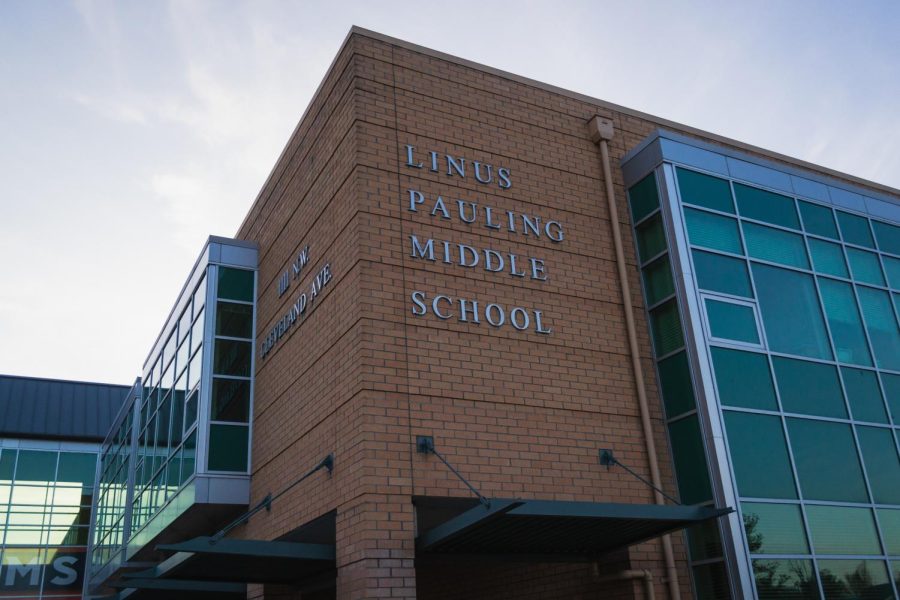Linus Pauling teacher walkout sparks larger conversation on student behavior
The building complex at Linus Pauling Middle School photographed on April 25, 2023. Several Corvallis school district changes have been established including the alternative pathway program.
April 26, 2023
In the months following the late February teacher walkout, Corvallis School District administrators have been meeting with CSD staff to gather input that has since informed some existing and planned changes for student behavioral expectations.
What started as a student threatening their teacher with a weapon, followed by inadequate administrative support became the straw that broke the camel’s back, causing the late February walkout involving eight teachers at Linus Pauling Middle School.
The next day, more unidentified teachers and staff met with Superintendent of the Corvallis School District, Ryan Noss, to speak with him about receiving stronger support and more solutions to deal with student behavior.
“Our district process is that schools take the lead in setting behavior expectations for their building and work with the district to identify solutions if these behaviors continue to increase or become more severe,” Noss said.
According to Communications Coordinator of CSD Kelly Locey, the administrators are currently aiming to create a document addressing the aforementioned input to be used by those schools.
From what the staff communicated to CSD, the main issues they’ve been facing with students have been:
- Students not being able to spend a full class period in a classroom
- Student usage of harsh language
- Refusal of reasonable requests from adults
- Students acting out aggressively
“Myself, Assistant Superintendent Melissa Harder, Principal Alicia Ward-Satey, and Middle School Coordinator Kim Johnson are working with building staff to revise the consequences for behaviors, [and] prioritize interventions that address the most frequent and problematic,” Noss said.
As a result of the feedback, the following work has been done:
- Modifying the electronic referral system allowing for improved communication to staff members about the administrative response to behavioral referrals.
- The district met with a team of middle school teachers and administrators to plan an alternative pathways model at the middle school for next school year.
- The Corvallis School Board approving funding for the middle school alternative pathway program.
- Piloting a middle school alternative pathway program at Cheldelin, which will continue through the end of the school year.
Corvallis School District has consequences for violence, harassment and bullying, sexual harassment, bias, weapons, vandalism or theft and violating student conduct outlined in their policies and guiding principles.
Students at Linus Pauling have also expressed their own frustrations with their classmates being disruptive in the classroom and hallways.
“Nationally, we are now seeing the impacts of the pandemic on kids’ mental health and development. We know that their mental health and development impact kids’ behaviors,” Noss said.
However, the Oregon Department of Education reported 31,269 students were disciplined in the 2021-2022 school year, 3,078 more than were disciplined in 2019-2020, but 6,068 fewer when compared to the 2018-2019 school year.
From kindergarten through twelfth grade, throughout the state of Oregon, in 2021-2022, there were 509 expulsions, 21,329 out-of-school suspensions and 9,431 in-school suspensions. Males were also being disciplined at a much higher rate than females, 21,567 to 9,549.
David Wrathall, a father and Oregon State University professor, believes that there is a pattern reflected by systemic problems.
“Teachers and policemen have ended up as the frontline first responders to our systemic problems,” Wrathall said. “Crisis management is not a teacher’s job.”
According to Wrathall, student behavior could be caused by accumulating stress from different factors such as bad socioeconomic conditions and technology, namely social media.
Wrathall believes that teachers have been forced to do more with less for a long time, and said they should have access to social worker resources so they aren’t forced to both teach and manage disciplinary actions in the classroom.
“Teachers are under pressure,” Wrathall said. “We need social workers. We need better social services. We need better programs for addressing poverty and inequality.”












































































































